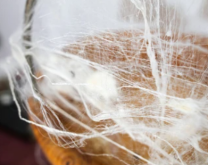
Silk fibroin is a biodegradable, non-toxic, biocompatible polymer. Silk fibroin is a structural protein raw material with significant market value potential, which can be widely used in green textiles, food and health care, medical devices, and other fields. The combination of natural polymers (collagen, hyaluronic acid, gelatin, chitosan) with silk fibroin changes the conformation and structure of the blend and modulates the mechanical properties of the blend. Lifeasible's team of personnel focuses on extracting silk fibroin and property modification services through development and innovation.
Lifeasible offers services for blending silk fibroin with various natural polymers to enhance the properties of silk fibroin by blending different types of polymers. We can also provide subsequent product performance and morphology testing.
We offer a blending and assembly service for silk fibroin and collagen. The extraction, purification, and structural identification of silk proteins are carried out first, followed by quantitative blending with collagen. Finally, a series of molecular dynamics and influencing factors analysis, morphological structure, and microstructure tests are performed on the resulting products.
We can provide the best ratio for mixing silk fibroin and chitosan. A certain concentration of silk fibroin solution is mixed with different concentrations of chitosan in different mixing ratios to prepare co-blended nanofiber membranes with different chitosan contents. The final product was analyzed and tested to find out the best performance of the silk fibroin/chitosan blended membrane.
Gelatin blending with silk fibroin not only improved the mechanical properties of gelatin but also increased the degradation rate of silk fibroin. The gelatin/silk fibroin composite fiber can be prepared by electrostatic spinning method with silk fibroin and gelatin as raw materials. The effect of different ratios of the two on the fiber can be investigated by regulating the addition ratio of the two.
Besides mixing with the above natural polymers, it can also be mixed with hydroxypropyl methylcellulose, elastin, pectin, honey, hyaluronic acid, pullulan, konjac glucomannan, silk gum, sodium alginate, agarose, glycerol, and keratin to modulate into different properties and functions.
The concentration of extracted silk fibroin solution is measured.
We perform morphological tests on the blended products, and the instruments used for the tests are usually scanning electron microscopes and transmission electron microscopes.
The samples are powdered, added to KBr powder in appropriate amounts, pressed, and tested by Fourier infrared spectroscopy. This is used to characterize the structural composition of the sample.
Mechanical testing instruments test the tensile strength, fracture strength, modulus and elongation at break, and the actual fracture strength is calculated, and the stress-strain curve is plotted.
These are the product tests that need to be performed when blending silk proteins with natural polymers, but if you need other types of new tests, please feel free to contact us. We will customize our solutions and products for you.
Lifeasible has established a one-stop service platform for plants. In addition to obtaining customized solutions for plant genetic engineering, customers can also conduct follow-up analysis and research on plants through our analysis platform. The analytical services we provide include but are not limited to the following:
Get Latest Lifeasible News and Updates Directly to Your Inbox
Adaptive Evolutionary Mechanism of Plants
February 28, 2025
Unraveling Cotton Development: Insights from Multi-Omics Studies
February 27, 2025